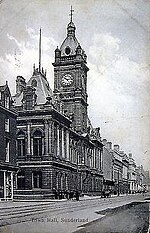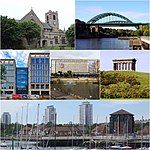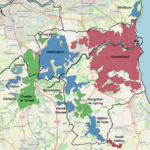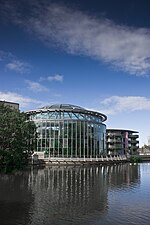Sunderland station
2002 establishments in EnglandDfT Category C2 stationsFormer North Eastern Railway (UK) stationsNorthern franchise railway stationsPages with no open date in Infobox station ... and 8 more
Railway stations in Great Britain opened in 1879Railway stations in Great Britain opened in 2002Railway stations in Tyne and WearRailway stations located underground in the United KingdomRailway stations served by Grand Central RailwayRailway stations served by London North Eastern RailwayTransport in the City of SunderlandUse British English from May 2014

Sunderland is a railway and metro station in Sunderland, Tyne and Wear, England. It is on the Durham Coast Line, which runs via Hartlepool and the city between Middlesbrough and Newcastle. It is owned by Network Rail and managed by Northern Trains. Since 31 March 2002, the station has also been served by the Tyne and Wear Metro's Green Line.
Excerpt from the Wikipedia article Sunderland station (License: CC BY-SA 3.0, Authors, Images).Sunderland station
Station Street, Sunderland Ashbrooke
Geographical coordinates (GPS) Address External links Nearby Places Show on map
Geographical coordinates (GPS)
| Latitude | Longitude |
|---|---|
| N 54.9061 ° | E -1.3824 ° |
Address
Sunderland
Station Street
SR1 3BY Sunderland, Ashbrooke
England, United Kingdom
Open on Google Maps









